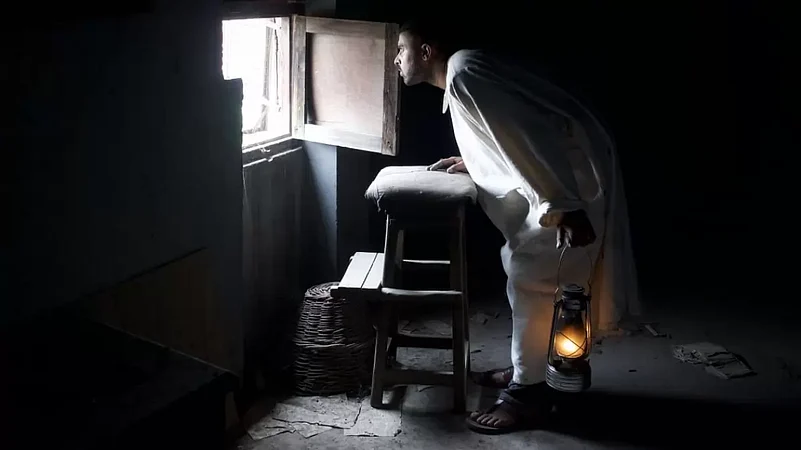The scene is silent and serene. Nasir Hassan, an interdisciplinary artist, is alone with his lantern, and thoughts. He is surrounded by the ruins of the Dara Shikoh’s mosque. It has been a symbol of city's culture and history for centuries. He looks around and takes it all in— the ruins of the mosque, the Jhelum River, the mountains, and the silence. He is surrounded by beauty and sorrow.
Wearing a long white pheran resembling a shroud, he walks on, his lantern still lit and approaches the river. He looks at the calm water and the reflection of moonlight in the river. He takes a deep breath and again, he looks around. He sees the beauty of nature and feels the peacefulness of the night.
He has captured this profound experience in his work, ‘Don’t Talk Ill About Others’, displayed at the fifth edition of the Kochi-Muziris Biennale this year. It is a compressed version of the project, primarily based on this year-long challenging performance of walking with a lantern. The ten-minute film represents his idea of human suffering, recorded through deserted roads, abandoned cinema halls, rivers and a poetry of longing, his own verses.
In ‘Don’t Talk Ill About Others’, we see Hassan in an abandoned cinema hall in Srinagar. He is seen squatting in a dark room with no clothes on his body. The lantern is next to him. He tears apart a shirt in bits and pieces. While he does this, old posters of veteran Bollywood film stars appear in flashes. In the next sequence, Hassan starts drawing sketches on a white wall, perhaps of children. Pain and discomfort are two emotions written all over his face. After that act, he picks up the lantern and jumps out of the window.
His narration of his own Kashmiri poetry creates a searing effect in the background. His performance stirs the imagination: Why is he tearing the shirt apart? Why is he at the ruins of Dara Shikoh’s mosque? Why is he making sketches of young children? Why is he carrying the lantern all along?
Hassan is not someone who would explain his art. He leaves it to the viewers. It does not bother him how people interpret it. He says the different interpretation of his work gives him a little comfort that he is able to convey his message, which he considers an important duty of an artist towards society.
Hassan says his performance has been spontaneous, whether it is tearing apart the shirt or his drawings. “Once I entered the abandoned cinema hall, I don't know what took over me and I started performing,” he says.
In his childhood, Hassan would see his maternal grandmother in the Qamarwari area of Srinagar going out every evening with a lantern and looking around on the lawn to check whether everything was fine. “When she would return, she would extinguish the lamp. Only then the family would feel safe, and go off to sleep,” says Hassan. The act of her grandmother is etched in his memory, and it has stayed with him.
That is why he walked with a lit lantern through different locations in his hometown Srinagar, Chandigarh, in Delhi, turning his body into an accessory of the landscape.
Hassan says he considers himself a witness to the past and tries to give clues about what has happened in the past, and how it might have happened. The ruins of Dara Shikoh might not have been ruins in the past, he says. “Maybe my grandmother had a different memory of it. My father might have a different memory of the abandoned cinema. It might not have been abandoned in his times. It might have been a happy place,” he says.
Hassan says he is in conversation with memory as his grandmother would always talk about her Kashmiri Pandit friend, who migrated from the Valley in 1990, his father’s idea of happiness when Kashmir was relatively peaceful and different and his own experience of growing up in Kashmir post-1990s, which has seen much turbulence is also in distinct.
Hassan is grasping with themes and trying to make art out of the everyday life around him—trauma, endurance and pain and of course past happiness. “One day, I thought why not use my own body as a landscape and perform,” he says.
And the next day, he started taking a lantern along for almost one year. He used to carry it everywhere, even to the University of Kashmir where he was studying in the Department of Fine Arts.
In the beginning, people laughed at him. Some told him that he was walking like ‘bram bram chok’. In Kashmiri folklore, ‘bram bram chok’ is a ghost-like creature who walks like a wolf, especially in the winter and carries a torch on its head and scares anyone who crosses his way. At the Bund and Residency road, where Hassan is seen often with his friends, a shopkeeper who regularly saw him carrying a lantern told him a story—long ago, the ghosts would come out from the Peerzu Island, a locality on the banks of the Jhelum River, with lanterns in their hand to frighten people.
However, Hassan’s intent was not to terrify people. He started carrying the ignited lantern along in the winter of 2022. The lantern became part of him. He started washing it. He started talking to it. He would keep it clean. “I started writing letters to it. I started telling stories to it and I started writing stories about it,” he says.
People had their own perspectives about the lantern in his hand. Some dismissed it. His parents got worried about what he was doing but Hassan always had his own view about it, and it necessarily doesn’t mean it had to be in sync with peoples’ ideas or thoughts. He used only one lantern for this year-long performance.
One day, the security forces stopped him as they were surprised to see a man carrying a lantern in the evening. Hassan had an artist’s pen folder with him. As the security forces opened the folder, they saw the cutter which the artists use to sharpen their pencils. The forces got suspicious, and Hassan got frightened and turned pale. Then someone among the security forces realised that he was an artist and they let him off saying: “Chitarkaar hai, jane do.” (He is an artist, let him go). Everyone laughed.
Hassan took his lantern to Delhi. While taking auto-rickshaw rides, auto drivers would tell him that the smell of kerosene oil coming from his lantern made them remember their childhood.
Once in the University of Jammu, Hassan was carrying the lantern along. A professor stopped and asked him whether he was protesting against some court verdict. Hassan just looked at him and asked him: “What is the verdict.”
Hassan likes to quote German Philosopher Friedrich Nietzsche’s “the Parable of the Madman” where the madman lit a lantern in the bright morning hours, ran to the marketplace, and cried incessantly: “I am looking for God! I am looking for God!” and ends up saying: “God is dead”. Hassan, however, contemplates it differently and gives it a very different meaning. “So many tragedies all around, it is not a humane sign. It is an ungodly sign,” Hassan says.
Hassan was pursuing a Bachelor’s in Business Administration (BBA) at the University of Kashmir when his grandmother died. After her death, he realised that there is no one he could talk to or can have a sincere conversation with. He felt a void in his life. Even now, when he talks, his grandmother dominates his stories. With grandmother not around, the lantern had become his friend.
After his grandmother’s death, Hassan got drawn to visual arts. He, however, says whatever is happening around him and whatever he has heard has had a deep impact on his work.
As a performance artist, Hassan says, he thinks that he often contemplates what he can do with his body and expresses himself and also remains safe and secure. But in Kashmir, it is a daunting task.


























